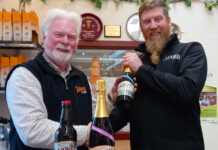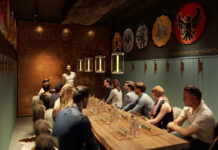Operators should take low and no-alcohol seriously in the coming year

THERE could be scope for Scottish venues to grow their sales of low and no-alcohol products in the coming months – but only if they take the category seriously.
Brand owners have insisted that the market for ‘low and no’ options is growing in the on-trade, but advised pub, bar and restaurant operators to give serious consideration to their range and how it is presented.
Faith Holland, head of category development, on-trade, at Diageo – the parent company of non-alcoholic spirit brand Seedlip – said the company expects to see “non-alcoholic spirits and drinks play an ongoing role over the next twelve months”.
“As we look to the year ahead, a strong low and no-ABV range represents a good opportunity for operators to drive sales in the new year and beyond,” said Holland.
This was echoed by James Morgan, business development manager for non-alcoholic drinks brand Nine Elms, who said the popularity of low and no-alcohol products has been growing throughout the pandemic.
The growth of low and no has definitely been maintained during the pandemic.
“Most no and low brands have seen record growth in the online channels, indicating accelerating demand as more people tried to lead healthier lifestyles during the pandemic,” said Morgan.
“The growth of the no and low sector has been definitely maintained if not increased by the pandemic and we expect to see some of this demand shift back to pubs and restaurants once we come out of the pandemic.”
Marcie Noble, on-trade sales director, west, at Tennent’s, said recent research carried out for the brewer and wholesaler had confirmed how much potential there is in the category.
She said: “We’re anticipating a year-on-year increase in no-low sales, with research conducted recently on behalf of Tennent’s finding that 25% of Scots surveyed would be interested in alcohol-free/low alcohol drinks in the next six months and that 34% of consumers are planning to drink more alcohol-free drinks in future.”
When selecting low or non-alcoholic products a good starting place is to stock “a beer, a non-alcoholic spirit and an unsweetened sparkling drink”, according to Sonja Mitchell, founder of non-alcoholic beer Jump Ship.
“If you’d normally prioritise quality and provenance, stick with it,” said Mitchell.
Margins are more generous on low and no-alcohol products because there’s no duty.
“There are some great Scottish craft drinks producers, from Rapscallion Soda, to Leftfield Kombucha, (alcohol-free spirit) Feragaia, and our own Jump Ship beers.
“Give customers a chance to discover something not normally available in the supermarkets.”
Mitchell added that, in the case of food-selling outlets, a low and no-alcohol range “is not just about replacing an alcoholic sale”.
“It’s also about trading customers up from simply ordering tap water,” she said.
This was reinforced by Andy Wingate, senior category manager at Heineken UK, who said margins on low and no-alcohol products can be higher than their alcohol-containing counterparts.
“Overall, the margins are more generous on no and low-alcohol than their alcoholic counterparts because there’s no duty involved,” said Wingate.
“What’s more, no and low alternatives deliver a higher RSP than soft drinks, so there’s a great financial benefit to be gained from adding no and low to your range.”
The way low and no-alcohol drinks are presented and promoted in outlets can also make a big difference, said companies.
However, opinions varied on the best way to highlight a range in outlets.
Morgan at Nine Elms said operators should “avoid grouping no and low options with soft drinks, as they are their own unique, sophisticated category”.
But Wingate, at Heineken UK, disagreed, arguing that as there tends to be crossover between consumers who would opt for soft drinks and those considering low and no-alcohol, the products should be close together in the fridge.
He said: “Consumers who drink soft drinks are more likely to consider no and low-alcohol options, but may not ask for non-alcoholic beer or cider specifically.
“Therefore, it’s important to range these products where the relevant consumers are looking (within soft drinks) to increase sales and customer satisfaction.”
And operators should make sure their staff are knowledgeable about any low and no-alcohol products and serves – including, in the case of food outlets, which pair with specific dishes on the menu.
“Train staff on which drinks complement different types of food,” said Mitchell at Jump Ship.
“Not serving alcohol doesn’t have to be downbeat – from our own experience at Jump Ship, drinkers are delighted when they find a drink they can enjoy without fear of a hangover and can still drive home or do an afternoon’s work.”
Morgan at Nine Elms said ensuring employees are knowledgeable about an outlet’s low and no-alcohol offer “is of the utmost importance”.
“Non-alcoholic alternatives shouldn’t be an afterthought to the main task of selling alcohol,” he said.
And Noble, at Tennent’s, said bartender recommendations carry serious weight in the on-trade.
She said: “Having a well-trained team is incredibly effective in showcasing your range – making sure your staff are familiar with the brands you stock and able to confidently make recommendations to your consumers.
“Research from CGA stated previously that 80% of consumers are willing to purchase based on bartender recommendation, so work with your wholesaler to see what training might be available.”
























